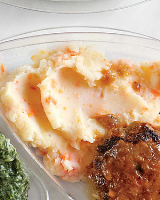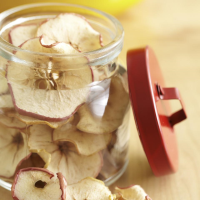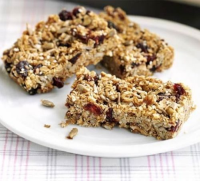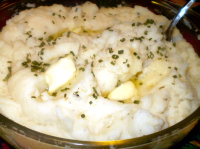HOW TO MAKE SOURDOUGH BREAD | BBC GOOD FOOD

Make a sourdough starter from scratch, then use it to bake a flavoursome loaf of bread with our simple step-by-step recipe.
Provided by Cassie Best
Categories Side dish
Total Time 1 hours 40 minutes
Prep Time 1 hours
Cook Time 40 minutes
Yield Makes 1 loaf
Number Of Ingredients 6
Steps:
- First, make your starter. In a large bowl, mix together 100g of the flour with 125ml slightly warm water. Whisk together until smooth and lump-free.
- Transfer the starter to a large jar (a 1-litre Kilner jar is good) or a plastic container. Leave the jar or container lid ajar for 1 hr or so in a warm place (around 25C is ideal), then seal and set aside for 24 hrs.
- For the next 6 days, you will need to ‘feed’ the starter. Each day, tip away half of the original starter, add an extra 100g of flour and 125ml slightly warm water, and stir well. Try to do this at the same time every day.
- After 3-4 days you should start to see bubbles appearing on the surface, and it will smell yeasty and a little acidic. This is a good indicator that the starter is working.
- On day 7, the starter should be quite bubbly and smell much sweeter. It is now ready to be used in baking.
- Tip the flour, 225ml warm water, the salt, honey and the starter into a bowl, or a mixer fitted with a dough hook. Stir with a wooden spoon, or on a slow setting in the machine, until combined – add extra flour if it’s too sticky or a little extra warm water if it’s too dry.
- Tip onto a lightly floured surface and knead for 10 mins until soft and elastic – you should be able to stretch it without it tearing. If you‘re using a mixer, turn up the speed a little and mix for 5 mins.
- Place the dough in a large, well-oiled bowl and cover. Leave in a warm place to rise for 3 hrs. You may not see much movement, but don’t be disheartened, as sourdough takes much longer to rise than a conventional yeasted bread.
- Line a medium-sized bowl with a clean tea towel and flour it really well or, if you have a proving basket, you can use this (see tips below). Tip the dough back onto your work surface and knead briefly to knock out any air bubbles. Shape the dough into a smooth ball and dust it with flour.
- Place the dough, seam-side up, in the bowl or proving basket, cover loosely and leave at room temperature until roughly doubled in size. The time it takes for your bread to rise will vary depending on the strength of your starter and the temperature in the room, anywhere from 4-8 hrs. The best indicators are your eyes, so don’t worry too much about timings here. You can also prove your bread overnight in the fridge. Remove it in the morning and let it continue rising for another hour or 2 at room temperature. The slower the rise, the deeper the flavour you will achieve.
- Place a large baking tray in the oven, and heat to 230C/210C fan/gas 8. Fill a small roasting tin with a little water and place this in the bottom of the oven to create steam. Remove the baking tray from the oven, sprinkle with flour, then carefully tip the risen dough onto the tray.
- Slash the top a few times with a sharp knife, if you like, then bake for 35-40 mins until golden brown. It will sound hollow when tapped on the bottom. Leave to cool on a wire rack for 20 mins before serving.
Nutrition Facts : Calories 245 calories, FatContent 1 grams fat, CarbohydrateContent 48 grams carbohydrates, SugarContent 1 grams sugar, FiberContent 2 grams fiber, ProteinContent 8 grams protein, SodiumContent 0.4 milligram of sodium
BASIC SOURDOUGH BREAD RECIPE | SIMPLE HOMEMADE SOURDOUGH BREAD
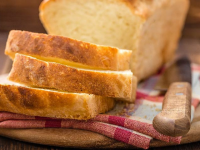
Provided by admin
Prep Time 30 minutes
Cook Time 30 minutes
Number Of Ingredients 16
Steps:
- Mix sourdough starter, flour, and salt together. Use enough water to make bread dough. (A moist dough is preferable to a dry dough.)
- Knead dough until it passes the “window pane test”: a small piece of dough will stretch between four fingers without breaking thin enough to allow light to pass through.
- Shape the dough into a loaf. Place in a pan or proofing basket, or on a board. Rub a little oil on the top surface of the dough and cover lightly with a towel or plastic wrap. Allow the dough to rise for 4-24 hours. If desired, a short (4-12 hours) proofing period can be used and the dough can be punched down, reshaped, and allowed to rise a second time, but a second proofing period is not required.
- Slice an X shape in the top of the loaf with a very sharp knife or razor blade.
- Bake at 400°F until the internal temperature reaches 210°F. (Use a meat thermometer inserted into the bottom or side of the loaf.) Bake 30-60 minutes (depending on loaf size). Cool before slicing.
More about "sourdough bread basket recipes"
BEGINNER'S SOURDOUGH BREAD | THE PERFECT LOAF
The perfect bread to get started baking sourdough bread at home. This crusty, crunchy, and absolutely delicious loaf of bread is perfect for any lunch or dinner table.
From theperfectloaf.com
Total Time 24 hours
From theperfectloaf.com
Total Time 24 hours
- (Preheat oven at 8:30 a.m., bake at 9:30 a.m.)Preheat your oven with a combo cooker or Dutch oven inside to 450°F (230°C).
See details
WHITE SOURDOUGH RECIPE - BBC GOOD FOOD | RECIPES AND ...
Master the art of making sourdough bread with our step-by-step recipe. Learn how to create a starter, levain and the loaf itself with our expert tips.
From bbcgoodfood.com
Total Time 1 hours 40 minutes
Category Side dish
Calories 171 calories per serving
From bbcgoodfood.com
Total Time 1 hours 40 minutes
Category Side dish
Calories 171 calories per serving
- Heat the oven to 240C/220C fan/gas 9 and put a lidded casserole dish in the oven to heat. Cut a sheet of baking parchment into a square slightly larger than the base of one of the loaves. Carefully remove the hot casserole dish from the oven and remove the lid. Invert one loaf onto the baking parchment, then, working quickly, score the top at an angle. Use the corners of the parchment to lift the loaf into the casserole dish. Cover with the lid and bake for 30 mins, then carefully uncover and continue to bake for another 10 mins (or longer for a darker finish). Carefully lift the bread out of the dish using a spatula, transfer to a wire rack and leave to cool to room temperature before slicing. Repeat with the second loaf.
See details
BEST SOURDOUGH BREAD RECIPE - HOW TO MAKE SOURDOUGH BREAD
Reward yourself with fresh homemade Sourdough Bread with this recipe from Delish.com.
From delish.com
Reviews 4.7
Total Time 19 hours
Category dairy-free, low-fat, low sugar, nut-free, vegan, vegetarian, brunch, picnic, weeknight meals, baking, breakfast, brunch, side dish
Cuisine American
From delish.com
Reviews 4.7
Total Time 19 hours
Category dairy-free, low-fat, low sugar, nut-free, vegan, vegetarian, brunch, picnic, weeknight meals, baking, breakfast, brunch, side dish
Cuisine American
- Autolyse: In a large mixing bowl, stir together flours and water with your hands until well combined. Cover and set aside in a warm part of your kitchen, ideally 78°, for at least 1 hour, up to 3 hours. Mix: Using your hands, add salt and starter to your dough and mix until well combined. Continue to work the dough by hand, using a shoveling motion to lift dough from the bottom up and let fall over itself until it becomes less sticky and can be picked up in one droopy piece, 3 to 4 minutes. (If dough still feels too slack, let rest for at least 10 minutes then continue to work the dough for 2 to 3 more minutes.) Bulk fermentation: This process will take 4 to 6 hours. Cover dough and set aside in a warm part of your kitchen for 30 minutes. After 30 minutes, perform your first set of stretch and folds: with wet hands, gently scoop up half of the dough from one side and lift up away from the bowl, then fold it over the remaining dough on the opposite side. Be firm but gentle: you want to lift until you feel tension from the dough but not until it tears. Turn the bowl a few degrees and repeat, working your way to stretch and fold around all 4 sides of the dough. It should now hold better shape than when you began. Gently flip the dough upside down so seams can rest underneath. Cover and let rest 30 minutes. Repeat stretching and folding every 30 to 60 minutes. As gluten develops, the dough will become tighter. Be gentle, do not force a fold if the dough is too tight. Instead, let it rest for a longer amount of time, up to 1 hour, before the next fold. Repeat the stretch and fold process until your dough feels like it can hold its shape, at least 4 sets. After the last set of stretch and folds, cover and let dough rest for at least 30 minutes, up to 2 hours. At the end of this bulk fermentation process, the dough should have risen between 20% and 50% in volume. Preshape: Gently loosen your dough from the bowl and turn it out onto a lightly floured surface. Flip the dough so that the smooth side is up. Dust dough lightly with flour. Using one floured hand and a bench scraper, pull dough towards you while rotating dough against the surface so that tension is developed across the top of the dough. Repeat this motion several times until your dough is smooth, plump, and round. Let rest uncovered for 10 minutes. Shape: Gently flip dough over so that the smooth side is facing down. With floured hands, you will fold the dough as if wrapping a package: lift the bottom side of the dough, stretch it a couple of inches toward you, and fold over most of the way towards the top side of the dough. Lift the left side of the dough and cross it over most of the way to the right, then lift the right side and cross it over to the left. Finally, lift the top side of the dough and fold it over all the way to the bottom, sealing the “package.” Flip the whole dough package over so that seams are facing down, pull dough towards you and rotate a few times to develop more tension across the loaf, then let rest uncovered for 2 minutes. Cold Proof: Heavily flour your banneton basket or a colander lined with a clean, lint-free tea towel. (Use more flour than you think you might need here to ensure the dough releases! You can always brush off excess before baking.) Using your bench scraper, gently reach under the dough and flip the smooth side into your free hand and transfer dough into the floured basket, smooth side down. Lightly flour the top of the dough, then place basket in a plastic bag and seal tightly. Let rest at room temperature for 15 minutes, then transfer to the fridge for 12 to 16 hours. Bake: Place a Dutch oven into the center of your oven and preheat oven to 500°. Once preheated, using long oven mitts, remove pot from oven and sprinkle bottom of pot with a generous layer of cornmeal or sesame seeds. Flip your dough upside down into the pot so that the smooth side is facing up. Use a pastry brush to brush off excess flour. Using a razor, sharp knife, or a pair of scissors, make one or more cuts across your dough to allow for expansion during the bake. Cover Dutch oven with a well-fitting oven-safe lid and bake for 20 minutes. Lower oven to 475° and bake covered for 10 minutes more. Uncover Dutch oven and continue baking until loaf is a dark caramel color, about 25 minutes. (Internal temperature of loaf should reach 208°.) Cool: Let cool inside pot for 5 to 10 minutes, then transfer to a cooling rack. Let loaf rest for at least 1 hour (preferably 2 hours) before slicing.
See details
CLASSIC SOURDOUGH BREAD | SOURDOUGH | RECIPES | DOVES F…
A sourdough loaf made with the simple basic ingredients of flour, water and a touch of salt. We used Einkorn to make the starter and ferment followed by strong white flour to make the dough. There are three distinct stages to making a sourdough loaf, the starter, the ferment and the dough itself. The starter will take 3 to 4 days to develop and then another 4–12 hours to be transformed into the ferment necessary to rise the dough. This bread is traditionally risen in a banneton which creates appealing lines on the baked loaf although it could be cooked in a regular loaf tin. The bread itself will have an appealing and complex sourdough taste and aroma.
* Alternatively, use Organic Wholemeal Emmer, Organic Wholemeal Spelt Flour or Organic Wholemeal Rye Flour.*
Before you begin to make your sourdough, we recommend reading our Guide to Sourdough Making alongside our handy Sourdough Starter Table.
From dovesfarm.co.uk
Reviews 4.9
From dovesfarm.co.uk
Reviews 4.9
- Starter – use this handy chart to help you keep track of your feeding times. On the first day, put one tablespoon of flour and one of water into a 500ml glass bowl and mix together. Wet a clean tea towel, wring it out well, lay it over the bowl and leave in a warm place for about 12 hours. After the 12 hours have passed, add another tablespoon of flour and another of water, mix together, cover with the damp tea towel and leave for another 12 hours. On day two (24 hours since beginning your starter), stir in a third tablespoon of flour and a third spoon of water, stir to mix, cover again with the damp tea towel and leave in a warm place for 12 hours. For the second feed of day two, add a tablespoon of flour and one of water, stir to mix, cover with the tea towel and leave in a warm place for 12 hours. For the first feed of day three (36 hours since beginning your starter), increase the feed by adding two tablespoons of flour and two of water, stir to mix. Re-damp the tea towel if necessary, lay it over the bowl and leave in a warm place for 12 hours. On the second feed of day three, add one tablespoon of flour and another of water, mix together, cover with the damp tea towel and leave for another 12 hours. At this point your starter should be bubbly and ready to create your ferment. If the starter is not showing bubbles, repeat the 12-hour feed and water routine, and ensure the starter is kept in a warm place. Ferment Once your starter is bubbly, stir it and measure 50g of the starter into a large mixing bowl. Pour 150ml water into the bowl and stir until lump free. Add 100g flour and stir to mix. Invert a larger mixing bowl over the dough bowl and leave in a warm place for 4-12 hours until bubbles appear. When bubbly, your ferment is ready to use (you can either dispose of any unused starter after bread making or keep and feed it regularly until your next baking session). 1st Dough Pour the tepid water into the ferment and mix well. Add the flour to the ferment and stir to mix. While the dough is still craggy and lumpy, stir in the salt. Using your hands gather everything together, gently pressing into a ball of dough. Knead the dough in the bowl for 100 presses without adding flour. Invert a large bowl over the dough bowl and leave in a warm place until double in size which may take 4–12 hours. 2nd Dough Dust the inside of the banneton liberally with flour. Run a spatula around the edge of the swollen dough. Pour the oil onto the dough and dip your fingers in the oil. Pick up the dough on the far side of the bowl, gently pulling and stretching it upwards then fold it forward onto the dough still left in the bowl. Turn the dough a quarter to the left or right. Repeat the action of lifting and stretching the dough then folding back onto itself five or six times, turning the bowl each time. Tuck the edges of the dough under to make a ball of dough. Transfer the dough into the floured banneton with the smoothest side down. Cover with an upturned mixing bowl and leave to roughly double in size, 2-12 hours. Baking Pre-heat the oven 20 minutes before you are going to bake. Rub some oil around the inside of an oven tray or insert a baking liner. Remove the upturned bowl and very gently tip the dough onto the oven tray. Bake for 35-40 minutes until golden brown. Transfer the bread to a wire rack and leave to cool. Click this link to find a handy Sourdough Starter Chart which when printed has space for you to enter the day and time that you feed your starter with flour and water and to help monitor progress. This Guide to Sourdough Making contains lots of hints and tips for successful sourdough bread making.
See details
SIMPLE BREAD MACHINE SOURDOUGH - HEART'S CONTENT F…
A truly simple sourdough recipe that is kneaded in your bread machine. A great everyday bread for the sourdough lover.
From heartscontentfarmhouse.com
Total Time 1155 minutes
Category breads
Cuisine American
Calories 138 kcal per serving
From heartscontentfarmhouse.com
Total Time 1155 minutes
Category breads
Cuisine American
Calories 138 kcal per serving
- When the oven has preheated, pour 1 cup of water onto the empty baking sheet to create steam. Immediately place the loaf inside, close the door, and bake for 45 minutes. Let cool on a wire rack for at least 4 hours before slicing. 7. Store at room temperature, well wrapped, for up to three days,
See details
SIMPLE WEEKDAY SOURDOUGH BREAD | THE PERFECT LOAF
Jan 30, 2020 · Method 1. Build Levain – 7:00 a.m. before work. A levain is simply an off-shoot of a sourdough starter, whereas a sourdough starter itself is never used up completely, it's continually fed day after day indefinitely.It's created with a small bit of a …
From theperfectloaf.com
From theperfectloaf.com
See details
EASY SOURDOUGH BREAD RECIPE - SAVOR THE BEST
Aug 10, 2021 · an easy sourdough bread recipe using your natural sourdough starter Do you need to knead the dough. Kneading dough helps form the gluten and gives the bread strength, structure, and better texture. With most bread recipes, in order to get the gluten …
From savorthebest.com
From savorthebest.com
See details
MY GO-TO SOURDOUGH BREAD RECIPE | HOW TO MAKE SOURDOUGH BREAD!
The Best Homemade Sourdough Bread Recipe. I can’t believe I’m finally sharing my sourdough recipes with you! I planned on doing a bunch of these staple recipes this fall when everyone was feeling like baking again, but now that we are all baking together at home, this …
From blessthismessplease.com
From blessthismessplease.com
See details
PERFECTLY CRUSTY SOURDOUGH BREAD FOR BEGINNERS | BIGGER ...
Apr 16, 2020 · Mine calls for 1/2 cup (4oz/115g) of my sourdough starter for a nice boule of sourdough bread. Just note that if you try a few different sourdough bread recipes from different sources, you CAN use my sourdough starter in any of them as long as you …
From biggerbolderbaking.com
From biggerbolderbaking.com
See details
HOW TO MAKE SOURDOUGH BREAD: ULTIMATE BEGINNER'S GUIDE (2022)
Jan 03, 2022 · The Science. Sourdough breads are made with wild yeasts and bacteria. Three basic ingredients – flour, water, salt – come together in a beautiful symbiotic rhythm to raise the bread naturally, as has been done for thousands of years.
From leavenly.com
From leavenly.com
See details
HOW TO MAKE SOURDOUGH BREAD: ULTIMATE BEGINNER'S GUIDE (2022)
Jan 03, 2022 · The Science. Sourdough breads are made with wild yeasts and bacteria. Three basic ingredients – flour, water, salt – come together in a beautiful symbiotic rhythm to raise the bread naturally, as has been done for thousands of years.
From leavenly.com
From leavenly.com
See details
PROOFING SOURDOUGH OVERNIGHT (OVERNIGHT RISE) - THE BREAD ...
Oct 10, 2017 · PERFECT SIZE FOR PERFECT SOURDOUGH - Diameter 10"(25cm), height 3.5"(8.75cm). Natural Rattan Basket Oval shape with accessories. Allows for 1.5lbs(0.6kg) of dough for a medium or large size loaf.
From thebreadshebakes.com
From thebreadshebakes.com
See details
COMPLETE SOURDOUGH STARTER KIT - BREAD KIT | YOU KNEAD ...
The sourdough starter kit gave me everything I need to ensure success - starter culture, flour, baneton basket, specialist tools and brilliant step-by-step instructions. I discovered that the secret is time. Sourdough bread making is a mindfulness practice and I am enjoying it thoroughly. Thank you You Knead Sourdough!
From youkneadsourdough.com.au
From youkneadsourdough.com.au
See details
SOURDOUGH RYE BREAD (WITH 100% RYE FLOUR) ⋆ MY GERMAN …
Jan 25, 2020 · Because rye flour has almost no gluten, we usually add about 40% of wheat flour to a rye bread, so it has a better texture. However, it is possible to bake bread with 100% rye flour. This is a very delicious and rustic bread …
From mygerman.recipes
From mygerman.recipes
See details
HOW TO MAKE SOURDOUGH BREAD | ALLRECIPES
Dec 21, 2020 · Your sourdough starter could take about 10 days of care and feeding before it's ready to use to bake sourdough bread, so build that into your timeline. Feed your starter every day at …
From allrecipes.com
From allrecipes.com
See details
HOW TO MAKE ARTISAN SOURDOUGH BREAD - BEST SOURDOUGH BREA…
Dec 04, 2020 · About 45 minutes before your bread is done rising, it’s time to get the oven ready! Turn it on to 500ºF and place a Dutch oven with its lid on inside to preheat. You want the Dutch oven to preheat for 30 minutes before baking your bread. The reason a Dutch oven works so well for baking sourdough …
From thepioneerwoman.com
From thepioneerwoman.com
See details
SPELT SOURDOUGH BREAD - SAVOR THE BEST
Aug 10, 2021 · Our Spelt Sourdough Bread is a wholesome and rustic loaf we just cannot get enough of! There’s nothing quite like a freshly-baked loaf of homemade sourdough bread, right?Crusty on the outside and soft and pillowy on the inside is what we’re going for, and this sourdough bread …
From savorthebest.com
From savorthebest.com
See details

















